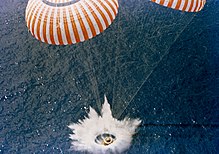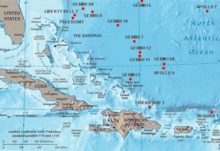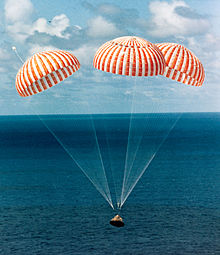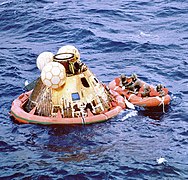Splashdown



Splashdown is the method of landing a spacecraft in a body of water, usually by parachute. The method has been used primarily by American crewed capsules including NASA’s Mercury, Gemini, Apollo and Orion along with the private SpaceX Dragon. It is also possible for the Russian Soyuz and the Chinese Shenzhou crewed capsules to land in water, though this is only a contingency.
As the name suggests, the capsule parachutes into an ocean or other large body of water. The properties of water cushion the spacecraft enough that there is no need for a braking rocket to slow the final descent as is the case with Russian and Chinese crewed space capsules or airbags as is the case with the Boeing Starliner crewed space capsule.
The American practice came in part because American launch sites are on the coastline and launch primarily over water.[1] Russian launch sites are far inland and most early launch aborts were likely to descend on land.[citation needed]
Missions
[edit]
The splashdown method of landing was used for Mercury, Gemini and Apollo (including Skylab, which used Apollo capsules). Soyuz 23 unintentionally landed on a freezing lake with slushy patches of ice during a snowstorm.[2][3]
On early Mercury flights, a helicopter attached a cable to the capsule, lifted it from the water and delivered it to a nearby ship. This was changed after the sinking of Liberty Bell 7. All later Mercury, Gemini and Apollo capsules had a flotation collar (similar to a rubber life raft) attached to the spacecraft to increase their buoyancy. The spacecraft would then be brought alongside a ship and lifted onto deck by crane.
After the flotation collar is attached, a hatch on the spacecraft is usually opened. At that time, some astronauts decide to be hoisted aboard a helicopter for a ride to the recovery ship and some decided to stay with the spacecraft and be lifted aboard ship via crane. All Gemini and Apollo flights (Apollos 7 to 17) used the former, while Mercury missions from Mercury 6 to Mercury 9, as well as all Skylab missions and Apollo-Soyuz used the latter, especially the Skylab flights as to preserve all medical data. During the Gemini and Apollo programs, NASA used MV Retriever for the astronauts to practice water egress.
Apollo 11 was America's first Moon landing mission and marked the first time that humans walked on the surface of another planetary body. The possibility of the astronauts bringing "Moon germs" back to Earth was remote, but not impossible. To contain any possible contaminants at the scene of the splashdown, the astronauts donned special Biological Isolation Garments and the outside of the suits were scrubbed prior to the astronauts being hoisted aboard USS Hornet and escorted safely inside a Mobile Quarantine Facility.[4]
Both the SpaceX Dragon 1 and Dragon 2 capsules were designed to use the splashdown method of landing. The original cargo Dragon splashed down in the Pacific Ocean off the coast of Baja California. At the request of NASA, both the crew and cargo variations of the Dragon 2 capsule splashes down off the coast of Florida, either in the Atlantic Ocean or the Gulf of Mexico.[5][6]
The early design concept for the Orion Spacecraft (then known as the Crew Exploration Vehicle) featured recovery on land using a combination of parachutes and airbags, although it was also designed to make a contingency splashdown (only for an in-flight abort) if needed. Due to weight considerations, the airbag design concept was dropped. The present design concept features landings via splashdown in the Pacific Ocean off the coast of California.[7]
Disadvantages
[edit]The most dangerous aspect is the possibility of the spacecraft flooding and sinking. For example, when the hatch of Gus Grissom's Liberty Bell 7 capsule blew prematurely, the capsule sank and Grissom almost drowned.
Since the spacecraft's flooding will occur from a location in its hull where it ruptures first, it is important to determine the location on the hull that experiences the highest loading.[8] This location along the impacting side is determined by the surrounding `air cushion' layer, which deforms the water surface before the moment of impact, and results in a non-trivial geometry of the liquid surface during first touch-down.[9][10][11]
If the capsule comes down far from any recovery forces, the crew are exposed to greater danger. As an example, Scott Carpenter in Aurora 7 overshot the assigned landing zone by 400 kilometers (250 mi). These recovery operation mishaps can be mitigated by placing several vessels on standby in several different locations, but this is quite an expensive option.
Locations
[edit]Crewed spacecraft
[edit]Uncrewed spacecraft
[edit]| Spacecraft | Agency | Landing date | Coordinates | Recovery ship | Miss distance | |
|---|---|---|---|---|---|---|
| Jupiter AM-18 (Able and Baker) |
USAF | May 28, 1959 | 48 to 96 km (30 to 60 mi) N Antigua Island | USS Kiowa | 16 km (9.9 mi)[57] | |
| Mercury-Big Joe | NASA | September 9, 1959 | 2,407 km (1,496 mi) SE Cape Canaveral | USS Strong | 925 km (575 mi)[58] | |
| Mercury-Little Joe 2
Sam The Rhesus Monkey |
NASA | December 4, 1959 | 319 km (198 mi) SE Wallops Island, Virginia | USS Borie | ? km[59] | |
| Mercury-Redstone 1A | NASA | December 19, 1960 | 378.2 km (235.0 mi) SE Cape Canaveral | USS Valley Forge | 12.9 km (8.0 mi)[60] | |
| Mercury-Redstone 2 | NASA | January 31, 1961 | 675.9 km (420.0 mi) SE Cape Canaveral | USS Donner[61] | 209.2 km (130.0 mi)[62] | |
| Mercury-Atlas 2 | NASA | February 21, 1961 | 2,293.3 km (1,425.0 mi) SE Cape Canaveral | USS Donner[61] | 20.9 km (13.0 mi)[63] | |
| Discoverer 25 (Corona 9017) |
USAF | June 16, 1961 | mid-air recovery missed | |||
| Mercury-Atlas 4 | NASA | September 13, 1961 | 257.5 km (160.0 mi) E of Bermuda | USS Decatur | 64.4 km (40.0 mi)[64] | |
| Mercury-Atlas 5 | NASA | November 29, 1961 | 804.7 km (500.0 mi) SE of Bermuda | USS Stormes | ? km[65] | |
| Gemini 2 | NASA | January 19, 1965 | 16°33.9′N 49°46.27′W / 16.5650°N 49.77117°W 3,423.1 km (2,127.0 mi) downrange from KSC | USS Lake Champlain | 38.6 km (24.0 mi)[66] | |
| AS-201 | NASA | February 26, 1966 | 8°11′S 11°09′W / 8.18°S 11.15°W 8,472 km (5,264 mi) downrange from KSC | USS Boxer | ? km[67] | |
| AS-202 | NASA | August 25, 1966 | 16°07′N 168°54′E / 16.12°N 168.9°E 804.7 km (500.0 mi) southwest of Wake Island | USS Hornet | ? km[67] | |
| Gemini 2-MOL | USAF | November 3, 1966 | 8,149.7 km (5,064.0 mi) SE KSC near Ascension Island | USS La Salle | 11.26 km (7.00 mi)[68] | |
| Apollo 4 | NASA | November 9, 1967 | 30°06′N 172°32′W / 30.1°N 172.53°W | USS Bennington | 16 km (9.9 mi)[67] | |
| Apollo 6 | NASA | April 4, 1968 | 27°40′N 157°59′W / 27.667°N 157.983°W | USS Okinawa | ? km[67] | |
| Zond 5 | USSR | September 21, 1968 | 32°38′S 65°33′E / 32.63°S 65.55°E | USSR recovery naval vessel Borovichy and Vasiliy Golovin | 105 km (65 mi)[69][70] | |
| Zond 8 | USSR | October 27, 1970 | 730 km (450 mi) SE of the Chagos Archipelago, Indian Ocean | USSR recovery ship Taman | 24 km[71][72] | |
| Cosmos 1374 | USSR | June 4, 1982 | 17°S 98°E / 17°S 98°E 560 km (350 mi) S of Cocos Islands, Indian Ocean | USSR recovery ship | ? km | |
| Cosmos 1445 | USSR | March 15, 1983 | 556 km (345 mi) S of Cocos Islands, Indian Ocean | USSR recovery ship | ? km | |
| Cosmos 1517 | USSR | December 27, 1983 | near Crimea, Black Sea | USSR recovery ship | ? km | |
| Cosmos 1614 | USSR | December 19, 1984 | ? km W of the Crimea, Black Sea | USSR recovery ship | ? km | |
| COTS Demo Flight 1 | SpaceX | December 8, 2010 | 800 km (500 mi) west of Baja California, Mexico, Pacific Ocean | ? | 0.8 km (0.50 mi)[73] | |
| Dragon C2+ | SpaceX | May 31, 2012 | 26°55′N 120°42′W / 26.92°N 120.7°W | ? | ?[74] | |
| CRS SpX-1 | SpaceX | October 28, 2012 | ? | American Islander[75] | ?[76] | |
| CRS SpX-2 | SpaceX | March 27, 2013 | ? | American Islander | ?[77] | |
| Exploration Flight Test 1 | NASA | December 5, 2014 | 23°36′N 116°24′W / 23.6°N 116.4°W, 443 kilometres (275 mi) west of Baja California | USS Anchorage | ||
| Crew Dragon Demo-1 | SpaceX | March 8, 2019 | In the Gulf of Mexico, off the coast of Pensacola, Florida | GO Searcher | ||
| SpaceX CRS-21 | SpaceX | January 14, 2020 | In the Gulf of Mexico, off the coast of Tampa, Florida | GO Navigator | ||
| Artemis I | NASA | December 11, 2022 | Pacific Ocean, west of Baja California | USS Portland | 4 nm | |
| IFT-4 | SpaceX | June 6, 2024 | Indian Ocean | |||
| IFT-5 | SpaceX | October 13, 2024 | Indian Ocean |
Gallery
[edit]-
The Apollo 15 spacecraft splashed down safely despite a parachute failure. (NASA)
-
Apollo 15 splashdown (NASA)
-
Apollo 11 after splashdown (NASA)
-
Apollo 13 hoisted onto ship (NASA)
-
Gemini water egress training
-
Recovery of the Dragon C2+ on May 31, 2012
-
Recovery of the EFT-1 Orion, December 5, 2014
-
Landing of SpaceX Demo-2, 2 August 2020
See also
[edit]- Apollo program
- Apollo–Soyuz Test Project
- Helicopter 66
- Project Gemini
- Project Mercury
- Skylab
- SpaceX Dragon 1
- SpaceX Dragon 2
- Water landing
- Zond program
Notes
[edit]- ^ "NASA article about American launch sites". NASA. May 14, 2009. Retrieved August 7, 2020.
- ^ Archived at Ghostarchive and the Wayback Machine: "The Accidental Spacecraft Splashdown Which Almost Killed Its Crew" – via www.youtube.com.
- ^ "Soyuz-23, Lands On A Frozen Lake". VideoCosmos. Archived from the original on April 14, 2012. Retrieved June 21, 2012.
- ^ Bob Fish. "Apollo 11 & 12 Recovery". USS Hornet Museum's website.
- ^ Clark, Stephen (January 12, 2021). "Cargo Dragon heads for splashdown off Florida's west coast". Spaceflight Now. Retrieved January 14, 2021.
- ^ "AUDIT OF COMMERCIAL RESUPPLY SERVICES TO THE INTERNATIONAL SPACE STATION" (PDF). Archived (PDF) from the original on October 9, 2022.
- ^ "Solar System Exploration: News & Events: News Archive: NASA Announces Key Decision For Next Deep Space Transportation System". Solarsystem.nasa.gov. May 24, 2011. Archived from the original on July 3, 2011. Retrieved June 21, 2012.
- ^ Jain, U.; et al. (2021). "Air entrapment and its effect on pressure impulses in the slamming of a flat disc on water". Journal of Fluid Mechanics. 938 (4): A31. arXiv:2012.10137. doi:10.1017/jfm.2021.846.
- ^ Jain, U.; et al. (2021). "Air-cushioning effect and Kelvin-Helmholtz instability before the slamming of a disk on water". Physical Review Fluids. 6 (4): L042001. arXiv:2106.09551. doi:10.1103/PhysRevFluids.6.L042001.
- ^ Verhagen, J.H.G (1967). "The Impact of a Flat Plate on a Water Surface". Journal of Ship Research.
- ^ Asryan, N.G. (1972). "Solid plate impact on surface of incompressible fluid in the presence of a gas layer between them". Izv. Akad. Nauk Arm. SSR Mekh.
- ^ Ezell (1988) p. 143
- ^ Ezell (1988) p. 144
- ^ Ezell, Volume II, p. 145
- ^ Ezell, Volume II, p. 146
- ^ Ezell, Volume II, p. 147
- ^ Ezell, Volume II, p. 148
- ^ Ezell, Volume II, p. 159
- ^ Ezell, Volume II, p. 160
- ^ Ezell, Volume II, p. 161
- ^ Ezell, Volume II, p. 162
- ^ Ezell, Volume II, p. 163
- ^ Ezell, Volume II, p. 164
- ^ Ezell, Volume II, p. 165
- ^ Ezell, Volume II, p. 166
- ^ Ezell, Volume II, p. 167
- ^ Ezell, Volume II, p. 168
- ^ Ezell, Volume II, p. 188
- ^ Ezell, Volume II, p. 189
- ^ Ezell, Volume III, p. 83
- ^ Orloff, p. 58
- ^ Ezell, Volume III, p. 84
- ^ Orloff, p. 78
- ^ Ezell, Volume III, p. 85
- ^ Orloff, p. 98
- ^ Ezell, Volume III, p. 86
- ^ Orloff, p. 120
- ^ Ezell, Volume III, p. 87
- ^ Orloff, p. 143
- ^ Ezell, Volume III, p. 88
- ^ Orloff, p. 168
- ^ Ezell, Volume III, p. 89
- ^ Orloff, p. 197
- ^ Ezell, Volume III, p. 91
- ^ Orloff, p. 225
- ^ Ezell, Volume III, p. 92
- ^ Orloff, p. 251
- ^ Ezell, Volume III, p. 104
- ^ a b Ezell, Volume III, p. 105
- ^ Ezell, Volume III, p. 112
- ^ "ASTP Apollo Miss Distance", ASTP Summary Science Report - Mission Description p. 36, Archived 2010-02-14 at the Wayback Machine
- ^ "Cosmonauts Land in Lake, Blizzard". The Milwaukee Journal. UPI. October 18, 1976.
- ^ "NASA Astronauts in SpaceX Capsule Make First Water Landing Since 1975". The New York Times. August 2, 2020.
- ^ "SpaceX Dragon splashes down in Gulf of Mexico, bringing 4 astronauts home". Orlando Sentinel. May 2, 2021.
- ^ "SpaceX capsule returns four civilians from orbit, capping off first tourism mission". CNN.com. September 18, 2021.
- ^ Jackie Wattles. "SpaceX's wildly busy year continues with astronaut splashdown". CNN. Retrieved May 6, 2022.
- ^ "Animals Survive 1,500-Mile Ride In Rocket Nose". The Windsor Daily Star. Windsor, Ontario. Associated Press. May 28, 1959.
- ^ "Big Joe Shot". nasa.gov. Retrieved August 9, 2018.
- ^ "Monkey Completes Long Flight Aloft". Ellensburg Daily Record. Ellensburg, Washington. December 4, 1959.
- ^ "Man-In-Space Capsule To Be Closely Studied". The Florence Times. Florence, Alabama. Associated Press. December 20, 1960.
- ^ a b "USS Donner LSD20". Homestead.com. Retrieved June 21, 2012.
- ^ "Chimp Survives Space Shot". The Milwaukee Sentinel. Associated Press. February 1, 1961.
- ^ "Space Capsule Soars 107 Miles High". The Florence Times. Florence, Alabama. Associated Press. February 21, 1961.
- ^ "U.S. Robot Orbited, Returned". Meriden Journal. September 13, 1961.
- ^ "Capsule Trouble Forces Early Landing Of Craft". Toledo Blade. Toledo, Ohio. Associated Press. November 29, 1961.
- ^ "Gemini 2 Distance traveled, Landing Point, Miss Distance", Manned Space Flight Network Performance Analysis for the GT-2 Mission; Pg V - Distance traveled, Page 21 - Landing Point, Miss Distance, (NASA X-552-65-204)
- ^ a b c d Mansfield, Cheryl L. (January 9, 2018). "Apollo-Saturn Unmanned Missions". NASA.
- ^ "Titan 3 Gives Spectacular Space Show". Sarasota Journal. Sarasota, Florida. November 3, 1966.
- ^ Michael Cassutt (2007). Red Moon. Tom Doherty Associates. p. 320. ISBN 978-1-4299-7172-0.
- ^ "Zond 5, Landing Point, Miss Distance" Archived 2011-09-27 at the Wayback Machine, NASA Solar System Exploration - Zond 5, Landing Point, Miss Distance.
- ^ Brian Harvey (2007). Soviet and Russian Lunar Exploration. Springer Science & Business Media. p. 218. ISBN 978-0-387-73976-2.
- ^ "Zond 8, Landing Point" Archived 2011-09-27 at the Wayback Machine, NASA Solar System Exploration - Zond 8, Splashdown area.
- ^ ""COTS 1 (SpaceX Dragon 1), Splashdown area"". Archived from the original on December 10, 2010.
- ^ "History is made as Dragon splashes down safely in the Pacific! | Bad Astronomy | Discover Magazine". Blogs.discovermagazine.com. Archived from the original on July 5, 2012. Retrieved June 21, 2012.
- ^ "American Island". marinetraffic.com. Retrieved August 9, 2018.
- ^ "Dragon Returns to Earth". NASA. October 28, 2012. Retrieved October 29, 2012.
- ^ "SpaceX brings home Dragon with 2,700 pounds of cargo". Spaceflightnow. March 26, 2013. Retrieved March 27, 2013.
Bibliography
[edit]- Ezell, Linda Neumann (1988), NASA Historical Data Book (PDF), vol. II Programs and Projects 1958 - 1968 (NASA SP-4012), archived (PDF) from the original on October 9, 2022
- Ezell, Linda Neumann (1988), NASA Historical Data Book (PDF), vol. III - Programs and Projects 1969 - 1978 (SP-4012), archived (PDF) from the original on October 9, 2022
- Orloff, Richard W., Apollo By The Numbers - A Statistical Reference (NASA SP-2000-4029) (PDF), p. 143, archived (PDF) from the original on October 9, 2022
External links
[edit] The dictionary definition of splashdown at Wiktionary
The dictionary definition of splashdown at Wiktionary










